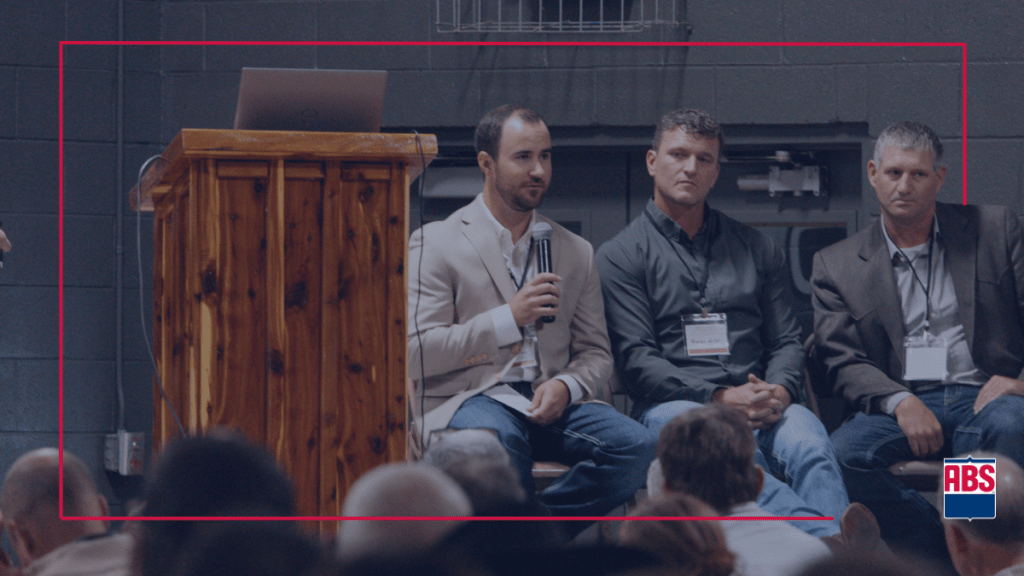Publish date: 10.23.25
Artificial Insemination (AI) has been a cornerstone of beef cattle reproduction for decades, but its role in today’s industry continues to evolve. Through advances in synchronization, genetics, and the use of sexed semen, AI is helping producers improve efficiency, profitability, and long-term herd performance. What was once considered a technology reserved for elite seedstock herds is now a proven, accessible practice used in both seedstock and commercial programs to improve consistency and performance.
That progress took center stage during a panel discussion at the Applied Reproductive Strategies in Beef Cattle (ARSBC) Conference, held in North Platte, Nebraska. The session brought together industry experts to share real-world insights into the implementation and success of AI programs in beef herds.
This panel was moderated by Dr. Joe Dalton from the University of Idaho, featuring:
- Bobby Strecker of ABS Global
- Brandon Miller of Genex
- John Herrick of Select Sires
Together, they discussed how technology, management, and mindset are shaping the next generation of beef reproduction systems. Each panelist offered a unique perspective, from practical management tips and breeding strategies to future innovations driving herd improvement.
“The genetic tools are only as powerful as the people using them. Our job as an industry is to help producers use those tools in a way that adds real value to their operations.” – Panel discussion at Applied Reproductive Strategies in Beef Cattle 2025
The Proven Payoff: Why Artificial Insemination Works
Across the panel, there was strong agreement that AI remains one of the most effective tools for herd advancement. AI programs consistently deliver improved conception rates, tighter calving windows, and heavier weaning weights, leading to a more uniform and profitable calf crop.
Panelists noted cows bred earlier tend to calve earlier, setting them up for better future fertility and longer herd longevity. Fixed-time AI protocols were highlighted as a reliable way to improve results without relying on visual heat detection, making the process more efficient for operations of varying sizes and labor availability.
Bridging the Gap: Combining Artificial Insemination and Natural Service
For herds not yet ready to transition fully into AI, the panel recommended using estrus synchronization with natural service as an effective intermediate step. This approach tightens the calving window and helps producers see measurable benefits before fully implementing AI.
“It’s a confidence builder,” Strecker added. “Once you see those calves hitting the ground together, it’s easier to take the next step.”
Smarter Sire Selection: Aligning Genetics with Goals
When it comes to sire selection, all three panelists emphasized aligning bull choice with production goals and marketing strategy. Artificial Insemination gives producers access to elite sires from across the country, enabling them to target traits such as calving ease, maternal performance, growth, and carcass merit; whatever best fits their program.
Rather than focusing on popularity, the panel encouraged producers to use data-driven selection tools like EPDs and DNA profiles to make balanced, long-term decisions that benefit herd structure and profitability.
Framing Up a Solid Foundation: Clear Goals, Skilled Technicians, Practical Facilities
The panel emphasized that success in any AI program begins with clear goals and the right people behind the chute. Establishing measurable objectives, such as building replacement females, improving carcass merit, or targeting specific market demands, helps shape the synchronization and sire selection plan to fit each operation.
“Every program has to start with the ‘why.’ If we know your goals, we can design a synchronization and sire selection plan that fits your operation.” – Bobby Strecker, District Sales Manager
The discussion also underscored the importance of functional, low-stress cattle handling facilities and skilled technicians. Strecker noted, “From the folks handling semen to the cattle day-to-day are the difference between good results and great ones.”
Panelists agreed that success doesn’t depend on elaborate setups, but on safe, efficient systems that reduce stress and keep cattle moving smoothly. Communication, consistency, and proper semen handling remain essential to ensure that reproductive technologies deliver to their full potential.
The Power of Sexed Semen: Custom Breeding for the Future
A major topic of discussion was the growing role of sexed semen in both beef and beef-on-dairy programs. The panel highlighted how this technology allows producers to “custom build” their herds. This flexibility, paired with AI and synchronization protocols, gives producers more control over their herd makeup, management efficiency, and marketing potential.
Strecker noted that conception rates with sexed semen have improved significantly in recent years, making it a reliable option beyond seedstock programs. “You can now build custom female programs and see consistent steer groups in the same place. It’s real-world, repeatable success.”
Takeaway: Applying Innovation with Purpose
The ARSBC panel emphasized that AI’s continued success depends not only on technology, but on thoughtful application. AI remains a proven tool, but its true value is realized when producers set clear goals, invest in good management, and make data-driven breeding decisions.
“At the end of the day, it’s about helping producers get more value from the cows they already have. That’s what drives progress in this business.” – Bobby Strecker
For genetics tailored to your goals and profitable cattle, contact your ABS Representative or fill out the form below.







